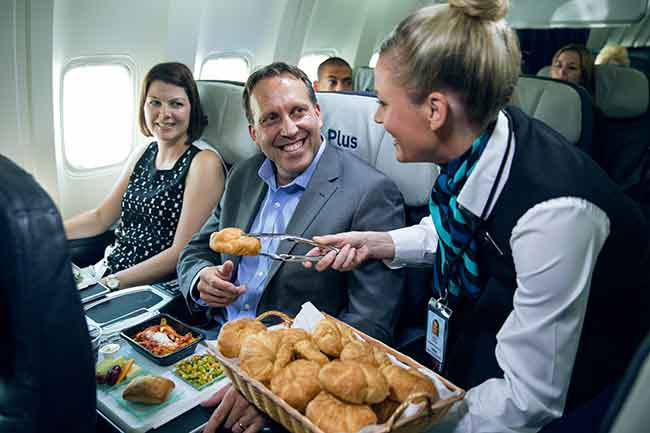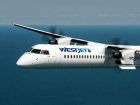
News
Spreading its wings
With a fourth Boeing 767 delivered this April, 2016 is shaping up as a watershed year for WestJet. The airline is re-tooling its Alberta base to adjust to a recession driven by plummeting oil prices, introducing its Encore regional subsidiary into the United States. It is launching 767-300ER service to London Gatwick from six Canadian cities, including daily from Toronto, five-times weekly from Calgary (three in the winter) and seasonal service from Vancouver, Edmonton and Winnipeg. St. John’s will also get daily service to the U.K. using Boeing 737-700 aircraft, which are ETOPS-certified.
May 3, 2016 By David Carr
 WestJet’s new “Plus” cabin is aimed at business and leisure travellers wanting more space and extra amenities. With a fourth Boeing 767 delivered this April
WestJet’s new “Plus” cabin is aimed at business and leisure travellers wanting more space and extra amenities. With a fourth Boeing 767 delivered this AprilThe 767s, which are later model ex-QANTAS airplanes, arrived in Canada sporting a new look. WestJet’s blue, white and teal colours remain, but the traditional “WestJet Ever-Expanding Horizon” logo, which featured a stylized mountain, has now been encased in a maple leaf. That logo will be displayed across the entire fleet. “Our intent was to use the logo on the 767s only, given the international nature of the routes they will serve. But the response has been so positive that we’ve decided to use it across our entire fleet,” says WestJet’s public relations manager Robert Palmer.
Since starting service 20 years ago, WestJet’s pathway to growth can be likened to an interlocking walkway; no new stone along the path is added before the previous stone is locked firmly in place. WestJet launched with a fleet of three classic Boeing 737-200s bought from Canadian Airlines in 1996. At the time, Canadian joked internally that those aircraft had so many hours on the airframe that the upstart would spend more time in the hangar than in the air competing for passengers.
Competitors aren’t laughing anymore. WestJet has methodically broke out of its western base, grabbed a 38 per cent market share nationally, added trans-border and sunspot destinations, hammered into place a codeshare program that now involves 16 U.S. and international airlines, overhauled its cabins to introduce a business-friendly product and resisted adding wide-bodied aircraft and the lure of overseas markets until its Encore regional strategy – flagged as a necessity to feed international routes – was firmly in place.
“In going into any market, it is always expected that we will have the cost advantage, price advantage and value advantage. That is our holy grail,” Bob Cummings, executive vice-president of commercial told Wings. “When we sit down and do our annual review the question is, what are the logical markets for our airline while staying true to our core market – which is leisure – while supporting and expanding our geographic reach based on that? That’s the DNA of where we are coming from. Of note is that at 20 years of age, our size and schedule is such that we are now relevant to the business and frequent flyer as well.”
Sticking with its DNA, WestJet deployed its 737 equipment to clear a path for the larger 767s across the North Atlantic. In 2014, the carrier tested the market by launching a seasonal daily flight from St. John’s to Dublin, Ireland. One year later, flights from Halifax to Glasgow, Scotland were added. Both services originate out of Toronto, but geography and the range of the 737 made Atlantic Canada the jumping off point – also stimulating a market that has traditionally been under-served with flights to Europe.
“The point of sale for international services started to develop with Dublin and Glasgow,” Cummings says. “Those routes gave us experience with the European GDS [global distribution system] getting used to currency issues and meeting our partners there. We always had our eye on taking it to the U.K. in a bigger way, so that worked out well.”
The U.K. is the Canadian transport industry’s most competitive overseas market, and WestJet is expected to be in tough entering such a crowded field. Montreal-based National Bank reports there will be at least 113 weekly flights this summer between six Canadian cities and London’s Heathrow, Gatwick and Stansted Airports, including Air Canada rouge, which announced daily flights between Toronto and Gatwick within days of WestJet outlining its U.K. plans.
“We pride ourselves on achieving our targeted return on investment capital,” Cummings explains. “This combined with where we can fly to, availability of slots and when we needed to move, we determined the time was right to go to Gatwick. London is a high margin [destination] for other carriers – we could get a healthy number of slots and only need to secure those slots every six years.”
Gatwick is an airport in transition. Largely considered a lower-cost airport supporting the leisure sector, Gatwick handled 31 million passengers last year, and is served by approximately 45 airlines, including ultra-low cost operator, easyjet, and is attracting more full service and business traffic. WestJet’s 767s will include a 24-seat premium cabin. The airline introduced its “Plus” enhanced economy product last year to appeal to business and leisure travellers wanting a little more space and extra amenities.
While WestJet is not part of a global alliance, it does have codeshare agreements with 16 airlines, including British Airways and Persian Gulf super-connector, Emirates which flies Airbus A380s twice daily out of Gatwick to Dubai. WestJet Encore will also plug into the mainline carrier’s London service with deep discount fares for connecting passengers.
Plotting where WestJet is headed next is as clear as drawing circles on a map. There may also be further opportunities for the airline to stretch its reach from Atlantic Canada using 737s. By summers end, the wide-body fleet is expected to do split duty between the U.K. and WestJet Vacations seasonal winter destinations, including Calgary and Hawaii – where the airplane cut its Canadian teeth. Other wide-body sun destinations will not be revealed until July.
“We gave a terrific leisure franchise out of Canada,” Cummings points out. “We have a 5,000-mile [8,000-kilometre] range 767. We could fly to a number of new winter destinations from Western Canada, from Toronto and from across Canada.”
Further down the road, more international flying will be based on a number of measurements, including performance on existing U.K. routes. “There are some tremendous and purposeful learnings heading into our wide-body launch on the European side. And going forward, we need to operate and pull through the Gatwick results. We will take some of those learnings as early as partway through the season to answer universal questions such as where we are going to fly and what the successful factors will be to operate to different parts of the world,” Cummings adds.
According to the WestJet senior vice-president, there are 150 wide-bodies operating from Canada, including 65 currently flying to Europe and 30 to Asian destinations. “We have dissected the flow: where there is heavy traffic, where there is traffic to be stimulated and where there is traffic to be moved in terms of market share. We have a host of opportunities. Doing it in a measured way, if you look at the growth rates in Asia and off a smaller base in South America – these are huge growth markets,” he says.
There are also opportunities to expand international service out of the Atlantic, where Cummings notes the airline has already carved out a nice niche. This summer, the region will be served with daily 737 flights to London and Dublin from St. John’s and Glasgow from Halifax, which is a growing hub for WestJet. Also on the go is the launch of Encore Q400 service to Boston, the second destination in the regional carrier’s push into the trans-border market (Toronto, Boston was Encore’s inaugural U.S. service, and will be followed by Nashville).
“There is more opportunity in Atlantic Canada,” Cummings says. “Drawing the range circle for the 737 you get into continental Europe, so there are still some markets available to us. We have set up Halifax with a growing number of [domestic] flights a day, and St. John’s with red-eye flights so there is a network to feed into the East Coast.”
Setting the versatile 737s aside, it appears that WestJet might be thin on the ground when it comes to the number of wide-bodied aircraft it is operating. Certainly the 767 is cheap, low-cost and easy to come by, but London may hold the answers on whether the type is a transitionary airplane for the carrier. WestJet is already in discussions with Airbus and Boeing over newer aircraft such as the A330, A350, 777 or 787. An approximate 13 per cent return invested capital on the London service is regarded as a tipping point for fleet decisions. Still, for Cummings, it remains the $125 million-plus question.
“Old planes versus new – you really need to do all the math on that,” he cautions. “We will gather all the data and decide whether it is prudent to keep going with used aircraft, which really flow through the financial models nicely. We will get into the market and we will look at the utilization of new aircraft to get pay back, what type of ‘front of the aircraft’ revenue we need, what type of cargo. There are all parts of the model in terms of choosing the right aircraft.”
At home, WestJet continues to wrestle with the benefit of lower oil prices, which have gutted its Alberta base, with a lower Canadian dollar. Approximately a quarter of WestJet’s flights originate from Alberta, and 55 per cent of the airline’s expenses are paid out in U.S. dollars. “It has moved around some traffic,” Cummings admits, including the Plus side of the cabin. “We had a real nice trajectory going until April of last year and then those [traveller] budgets started to get cut. For the first time in a number of years, we saw that particular region’s growth flatten and dip at the end of the year. In the last couple of months, we are starting to see another levelling off. Ideally, an upturn starts soon.”
WestJet has responded to the economic churn by deferring deliveries of some 737 aircraft and shifted some capacity out of Alberta to the busier Vancouver and Toronto markets. “We have pockets in Canada that are very strong, and Alberta is maintaining a core level of flying,” Cummings says. “At any time there is the benefit of upward forces and there are the downward forces. Over the long run, they seem to level out. Underneath that, you keep your fundamentals strong in terms of being low-cost and offering a good experience.”
Despite the sudden downtick in the Alberta market, WestJet is not altering course with respect to year-round flights to Gatwick. Air Canada has already reduced capacity on its Calgary to London route. WestJet believes that the pieces are in place to fill its weekly 767s (five from Calgary and two from Edmonton), including the strength of its brand. “We have such a strong franchise with the Alberta community. Whenever we introduce a new service like WestJet Vacations or Encore it has been gobbled up. Not only in Alberta, but in Western Canada – and Canada in general,” Cummings notes.
WestJet, which was the original, low-cost market stimulator in Canada, believes it is positioned to compete for the next frontier in Canadian air transport, the ultra-low cost carrier (ULCC). In a high dollar, high-cost environment, established Canadian airlines like WestJet, Air Canada and Transat were already competing against American ULCCs at border cities, a sector that has slowed as the rising American dollar ate into travel bargains, but will also rebound as the Canadian dollar strengthens.
“We are very wary of that part of the [ULCC] market,” Cummings says. “Encore has really strengthened our overall network with new destinations flying into what we are now calling our hubs. It is offering new spokes, creating new connections and is adding frequencies for flying under 700 miles (1,126 kilometres). It has created new utility with respect to our value proposition. We now not only talk about price stimulation, but as we continue to penetrate non-core markets like the wide-bodied market, we are talking about how we handle loads on O&Ds versus non-stop. We will continue to focus on stimulating the market, putting people on airplanes rather than driving in cars and making more trips. Furthermore, we are looking at our fare products, cabin configurations and other competitive considerations for this part of the market. As the consumer market evolves, we will evolve as well.”


